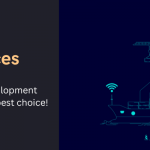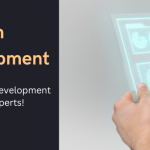
How to Get the Best Custom Medical IoT Development
The Internet of Things (IoT) is transforming numerous industries, and healthcare is no exception. Medical organizations that aim for better health monitoring, patient data collection and analysis, and improved management increasingly implement this cutting-edge tech.
As a result of this increased demand, the medical IoT market is projected to grow by 20.41% annually. To put this in numbers: from over $180 billion in 2021, it will surpass $960 billion in 2030.
Healthcare companies that want to adopt this thriving technology are probably thinking about how to do it best. Today’s article will dwell on this by providing tips on choosing top IoT healthcare engineers for IoT solutions development. We’ll also share the latest trends and use cases of the Internet of Things in the medical industry.
IoT in Healthcare: How Does It Work and Where Is It Typically Used?
Before the introduction of health care IoT, patients had no choice but to visit their doctors in person or, in the best cases, via telemedicine. Physicians, in turn, couldn’t constantly monitor their patient’s condition and provide timely recommendations.
Yet, the situation has changed dramatically with the adoption of healthcare IoT solutions. The Internet of Things has brought remote patient monitoring and treatment to a new level thanks to various wearable IoT devices. But how exactly does it all work?
IoT involves using wearables for collecting, exchanging, and analyzing patient data. This tech works for all parties in the medical industry:
- Patients. People wear IoT devices like blood pressure and heart rate monitors, glucometers, or fitness bands, which collect and send health data to physicians.
- Doctors. Physicians receive data from IoT devices to track patients’ health more efficiently. They can use this data to improve treatment plans, make more accurate predictions, and respond to changes in the patient’s condition timely.
- Hospitals. Healthcare facilities can use IoT beyond monitoring patient health. They may involve IoT sensor development for real-time medical equipment tracking, drug management, hygiene control, and environmental monitoring, e.g., checking the hospital’s temperature and humidity levels.
All parties involved benefit significantly from the adoption of IoT for healthcare. However, these advantages are only practical if the technologies are used correctly. In this regard, one cannot do without experienced IoT developers. To attract reliable specialists, you need the following:
- Establish clear requirements for your medical IoT project
- Make sure your candidates have relevant healthcare development experience
- Check your IoT healthcare engineers’ portfolio
- Ensure transparent communication
- Interview and hire IoT software developer
After that, you can adopt IoT in your medical organization in a few steps:
- Deploying IoT devices that include sensors, monitors, detectors, camera systems, etc., that will facilitate data collection
- Ensuring digitization of collected data
- Processing the collected digital data and transferring it to the cloud or data center
- Analyzing and managing collected data for better decisions and valuable insights
Above, we described a generalized process for medical IoT adoption. But there are more specific use cases and innovations that you should consider. Read on to learn more.
IoT Healthcare Innovations and Trends
With telemedicine and AI in medical processes, IoT solutions for healthcare projects evolve as well. Here are the Internet of Things innovations and trends you can expect in the following years.
Wearable Tech
Since IoT is all about wearables, this technology will further expand in the healthcare industry. According to Grand View Research, the global wearable technology market will grow from over $71 billion in 2023 to $186 in 2030. This tech is helpful in patient monitoring and timely treatment.
Sensor Tech
Sensors are medical IoT solutions that can facilitate patient-doctor interaction, diagnosis, and equipment maintenance. These are pieces of hardware installed in medical devices that help measure oxygen, airflow, pressure, temperature, etc., to enable proper operation of the equipment. With IoT in place, tracking these indicators can be done remotely and with little manual intervention, streamlining the medical staff’s work.
AI-Enabled IoT
Artificial intelligence in medicine is expanding at a breakneck pace, growing from $20 billion in 2023 to an impressive $188 billion in 2030. What’s more interesting is that IoT solutions for healthcare cannot do without AI. Since the Internet of Things involves gathering vast amounts of data, there should be means to process and analyze it efficiently. So here comes AI with algorithms that can streamline those processes.
Personalized Healthcare
In 2021, 38% of healthcare professionals focused solely on personalized approaches to medical treatment. And IoT technology is one of the means of tailored medicine. Gathering real-time data from patients’ wearable devices can help prevent diseases and select the most suitable treatment plans.
Medical Research
Another trend worthy of attention is the use of the Internet of Things for medical research. Scientists can save a lot of time collecting data needed, for example, for disease statistics, owing to IoT. This technology can also save a lot of money, which is why there is so much interest in it.
Where Can I Hire IoT Software Developers?
If you aim to implement smart healthcare using IoT, engaging experienced IoT developers is necessary. But where and how can you find such experts? Here are a few suggestions.
First of all, you need to decide on your hiring model. You can choose between the following options:
- Engaging an in-house healthcare developer. This model involves hiring a professional within your location who will work as your team member. It may be costly, especially if the dev rates in your country are high, but you can benefit from a full-time expert’s commitment and management of all processes right from your office.
- Outsourcing medical IoT development. Locating a remote team is a cost-effective option. It offers numerous benefits like accessing extensive expertise in healthcare, automotive IoT, or any other industry, the flexibility of dev processes, and the ability to hire specialists for both long and short-term projects effortlessly.
- Hiring a freelance IoT developer. This option involves locating independent specialists that usually work on an hourly basis. It’s cost-effective, flexible, and best for short-term projects or minor improvements.
According to the recruitment model, you will search for workers using different means. We have prepared a selection of resources and platforms where you can find in-house, outsourced, and freelance healthcare developers.
- Job aggregators. You can locate IoT developers through platforms like Glassdoor, Indeed, or CareerJet.
- Freelance platforms. You can use Upwork, TopTal, or Fiverr to hire a freelancer.
- Professional social networks. Use LinkedIn, Jobcase, or Meetup to find the best candidates through social media.
- IoT dev agencies. Just google ‘medical IoT development’ and review the companies which appear in your search results.
On top of that, you may use networking to find IoT developers. All you need to do is ask around. Maybe some of your friends know about a decent company for healthcare development.
IoT Solutions for Medical Projects: Real-Life Cases and Examples
Are you still hesitating about whether to adopt IoT smart healthcare? Many companies are doing this right now. We’ll provide you with real-life use cases of this technology and talk about popular IoT devices.
Microsoft
This technology giant has developed its cloud-based platform Microsoft Azure, which supports providing various medical services. On top of that, it facilitates health care IoT security because all data is stored in the cloud.
Apple
You’ve probably heard about the Apple Watch. The latest Apple Watch Series 8 model is nothing but an IoT device. It allows you to measure heart rate, body temperature, and blood oxygen level. Moreover, this device helps monitor sleep phases, detect the device owner’s fall, and automatically call emergency services.
Pfizer
Pfizer has implemented IoT for a variety of processes. The company partnered with IBM to improve immuno-oncology research and used IoT sensors to track the manufacturing and distribution of COVID-19 vaccines and ensure safe temperatures during transportation.
Proteus
Proteus Digital Health is a driver of digital medicine. The company’s Proteus Discover solution is a device that consists of ingestible sensors connected to a mobile application. It makes it possible to collect data about the patient’s condition in real time, make accurate diagnoses, and prescribe appropriate treatment plans.
Conclusion
The demand for medical IoT is growing day by day. Healthcare organizations adopt this tech to improve continuous patient monitoring, drive medical research, gather and analyze health data, and provide better treatment.
IoT implementation involves using wearables, sensors, and other tools for medical care. Connecting these tools with healthcare software enables high-quality healthcare services based on data-driven insights. Yet, implementing those necessitates having reliable IoT specialists on board.
If you need healthcare developers knowledgeable about medical IoT for your project, our team can help. We can handle IoT software and hardware development of any complexity to improve your organization’s operations.




